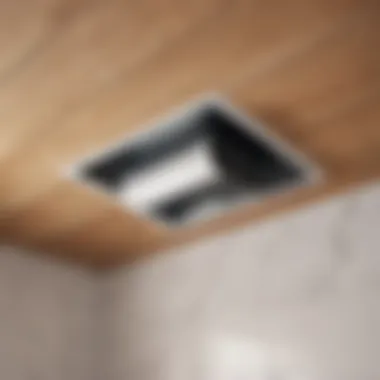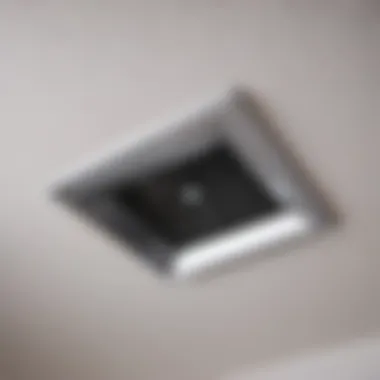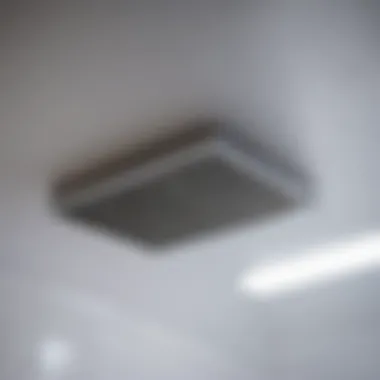Enhancing Bathroom Air Quality through Effective Vent Duct Optimization


Materials:
- Vent Ducts: Make sure to measure the length needed for proper air circulation efficiency
- Connector Pieces: To join the ducts together accurately
- Fasteners: Screws or clamps to secure the ducts in place
- Vent Cover: For the external part of the vent to prevent debris from entering
DIY Steps:
- Measure and Plan: Determine the length of vent ducts required based on your bathroom size
- Cut and Connect: Cut ducts to the measured size and connect them using connector pieces
- Secure Vent Ducts: Use fasteners to secure the ducts in place, ensuring stability
- Install Vent Cover: Place the vent cover on the exterior part of the duct to prevent blockages
Technical Aspects:
- Tools Needed: Measuring tape, duct cutter, screwdriver, clamps
- Timing Specifics: Allocate 1-2 hours for complete installation
- Critical Techniques: Ensure a proper seal at all connections for optimal airflow
DIY Project Process:
- Start by measuring the bathroom dimensions and planning the duct layout accordingly
- Cut the ducts precisely to fit the measurements and connect them with care
- Secure the ducts in place using fasteners to avoid movement or vibrations
- Install the vent cover securely to prevent any foreign objects from blocking the airflow
Troubleshooting Tips:
- Issue: Poor Airflow
- Issue: Noisy Ventilation
- Solution: Check for any blockages or leaks in the ducts and reseal connections if necessary
- Solution: Ensure all connections are tightly secured to reduce vibrations
Enjoying the Result
After following these detailed steps and guidelines, your bathroom vent ducts should now be optimized for improved air circulation, leading to better air quality and reduced risks of mold growth. Regular maintenance of the vent system is recommended to ensure long-term effectiveness.
Understanding Bathroom Vent Ducts
Understanding bathroom vent ducts is crucial for optimizing air circulation in a bathroom environment. The ventilation system plays a pivotal role in ensuring proper air quality and preventing issues such as mold and mildew formation. By grasping the components and types of vent ducts, individuals can make informed decisions to enhance their bathroom's overall functionality and air circulation efficiency.


Importance of Ventilation Systems
Enhancing Indoor Air Quality
Enhancing indoor air quality is a critical aspect of a ventilation system. By removing stale air and moisture, it helps in reducing allergens and pollutants, creating a healthier living environment. The efficient circulation of fresh air provides comfort and promotes well-being within the bathroom space. However, it is essential to choose quality ventilation systems to ensure optimal air purification and circulation.
Preventing Mold and Mildew Formation
Preventing mold and mildew formation is another key function of a ventilation system. By eliminating excess moisture from the air, vent ducts help in controlling humidity levels, which are conducive to mold growth. This preventive measure not only enhances bathroom hygiene but also extends the longevity of the bathroom fixtures and surfaces. Regular maintenance and proper usage of ventilation systems are essential to combat mold-related issues effectively.
Components of a Ventilation System
Extractor Fan
The extractor fan is a fundamental component of a ventilation system. It aids in drawing out humid air and odors from the bathroom, promoting air circulation and maintaining freshness. The key characteristic of an extractor fan lies in its ability to efficiently expel air outdoors, preventing the buildup of moisture and pollutants. While extractor fans are essential for effective ventilation, selecting the right size and power capacity is crucial for optimal performance in the bathroom setting.
Vent Ducts
Vent ducts serve as conduits for air transport within the ventilation system. These ducts come in various materials such as aluminum, metal, and plastic, each offering distinct advantages in terms of durability and flexibility. The key characteristic of vent ducts is their role in guiding air flow from the extractor fan to the external environment, ensuring efficient ventilation. Proper insulation and sealing of vent ducts are essential to prevent air leaks and maintain air circulation efficiency.
Vent Covers
Vent covers act as protective barriers for vent openings, regulating air flow and preventing debris from entering the ventilation system. The key characteristic of vent covers lies in their ability to enhance the aesthetic appeal of the bathroom while maintaining functionality. It is important to choose vent covers that complement the bathroom decor and facilitate adequate air exchange without compromising on design aesthetics.
Types of Vent Ducts
Flexible Aluminum Ducts
Flexible aluminum ducts offer versatility and ease of installation in ventilation systems. The key characteristic of these ducts is their pliability, allowing for bending and routing in confined spaces without compromising airflow. The unique feature of flexible aluminum ducts is their resistance to high temperatures and moisture, making them ideal for use in bathrooms and other damp environments. While flexible aluminum ducts are lightweight and adaptable, proper support and securing are necessary to prevent kinking and airflow restrictions.
Rigid Metal Ducts


Rigid metal ducts are known for their durability and sturdiness in ventilation applications. The key characteristic of these ducts is their rigid structure, which ensures consistent airflow and minimizes obstructions. The unique feature of rigid metal ducts is their longevity and resistance to wear and tear over time, providing a long-lasting solution for ventilation needs. While rigid metal ducts offer superior performance and durability, careful planning and measurements are essential for precise installation to optimize air circulation efficiency.
Plastic Ducts
Plastic ducts are lightweight and cost-effective options for ventilation systems in residential settings. The key characteristic of plastic ducts is their affordability and ease of handling during installation. The unique feature of plastic ducts is their resistance to corrosion and moisture, making them suitable for use in bathrooms with moderate ventilation requirements. While plastic ducts offer budget-friendly alternatives, proper maintenance and periodic inspections are necessary to prevent premature deterioration and ensure long-term functionality.
Installation of Bathroom Vent Ducts
When it comes to optimizing air circulation in your bathroom, the installation of bathroom vent ducts plays a pivotal role. Proper installation ensures that the ventilation system functions efficiently and effectively, contributing to superior indoor air quality and the prevention of mold and mildew formation. By focusing on the specific elements of installation, such as determining optimal placement, routing the vent duct, and securing the ductwork, homeowners can create a conducive environment for better air circulation.
Determining Optimal Placement
Proximity to Shower or Bath
A critical aspect of optimizing bathroom vent ducts is determining the proximity to the shower or bath. Placing the vent duct close to these moisture-prone areas is beneficial as it helps in expelling excess humidity quickly, reducing the chances of mold and mildew growth. This strategic placement allows for the efficient capture and extraction of steam and odors, promoting a fresher bathroom environment. While the proximity to water sources is advantageous for ventilation, it's essential to consider the potential exposure to moisture-related damage over time.
Distance from Toilet
Another key consideration in optimizing bathroom vent ducts is the distance from the toilet. Positioning the vent duct away from the toilet area helps in preventing odors from spreading throughout the bathroom. By maintaining a reasonable distance, homeowners can ensure that the ventilation system primarily targets air quality near wet areas instead of being overwhelmed by toilet odors. However, it's crucial to strike a balance between effective ventilation and convenient accessibility for maintenance purposes.
Routing the Vent Duct
Avoiding Sharp Bends
Efficient airflow is paramount in a ventilation system, making the avoidance of sharp bends crucial in routing the vent duct. Sharp bends can disrupt the smooth flow of air, causing blockages and reducing the system's effectiveness. By opting for gradual bends or curved routes, homeowners can maintain a steady airflow velocity and ensure optimal performance of the ventilation system. This deliberate routing minimizes resistance and enhances the overall air circulation within the bathroom.
Ensuring Proper Slope for Drainage
Maintaining a proper slope for drainage in the vent duct is essential to prevent water accumulation and potential blockages. By ensuring that the ductwork slopes downward towards the exit point, condensation and moisture can flow out efficiently, reducing the risk of stagnant water within the system. Proper drainage slope also aids in the prevention of mold and mildew formation by facilitating the removal of excess humidity. This meticulous attention to detail in routing enhances the longevity and functionality of the ventilation setup.
Securing the Ductwork


Use of Metal Strapping
Securing the ductwork with metal strapping is a reliable method to ensure stability and structural integrity. Metal strapping provides robust support to the duct system, preventing sagging or dislocation over time. This secure fastening method reinforces the installation, especially in areas prone to vibrations or movements. The use of metal strapping enhances the durability of the vent duct setup, minimizing the risk of dislodgment and preserving optimal airflow within the bathroom.
Proper Sealing Techniques
Proper sealing techniques are imperative for maintaining airtight connections and preventing air leakage in the ductwork. By using high-quality sealants and fitting materials, homeowners can seal gaps and joints effectively, promoting seamless airflow pathways. A well-sealed ventilation system ensures that air is directed efficiently towards the desired exit point, optimizing ventilation performance. Additionally, proper sealing mitigates the intrusion of external elements, such as insects or dust, preserving the overall cleanliness and functionality of the bathroom vent ducts.
Maintenance of Vent Ducts
Cleaning and Clearing Blockages
Removing Dust and Debris
Removing dust and debris from bathroom vent ducts is a critical aspect of maintenance. This process involves thorough cleaning of the ducts to eliminate any accumulated particles that can obstruct airflow. By ensuring that ducts are free from dust and debris, the ventilation system can operate more effectively, promoting better air circulation and reducing the risk of blockages.
Checking for Bird Nests
Another key element of maintenance is checking for bird nests within the vent ducts. Bird nests can obstruct airflow, leading to reduced ventilation efficiency and potentially causing issues such as poor air quality and increased moisture levels. By regularly inspecting and removing any bird nests, homeowners can optimize their ventilation system and minimize the risk of related problems.
Inspecting for Damage
Signs of Wear and Tear
Inspecting vent ducts for signs of wear and tear is essential in maintaining an efficient ventilation system. Signs of wear, such as cracks or dents, can indicate potential issues that may affect the performance of the ductwork. By identifying and addressing these signs early on, homeowners can prevent further damage and ensure the continued functionality of their bathroom vent ducts.
Leaks and Corrosion
Detecting and addressing leaks and corrosion in vent ducts is crucial for preventing air leaks and maintaining optimal airflow. Leaks and corrosion can lead to energy loss and decreased ventilation performance. By promptly repairing any leaks and addressing corrosion issues, homeowners can enhance the efficiency of their ventilation system and prevent potential problems.
Upgrading Ventilation System
Replacing Old Ductwork
Upgrading the ventilation system by replacing old ductwork can significantly improve air circulation in the bathroom. Old ductwork may be inefficient or damaged, hindering the overall performance of the ventilation system. By replacing old ductwork with newer, more efficient materials, homeowners can enhance airflow, reduce energy consumption, and improve indoor air quality.
Installing Energy-Efficient Ventilation
Installing energy-efficient ventilation components is another key aspect of optimizing bathroom vent ducts. Energy-efficient ventilation systems can help reduce energy costs, minimize environmental impact, and enhance overall air circulation. By integrating energy-efficient ventilation options, homeowners can create a more sustainable and efficient bathroom environment.







